Across the vast tapestry of cultures and epochs, weddings have always been celebrated with fervor and joy. Central to these celebrations are the customs and rituals that define them, with makeup playing a pivotal role in many. Dive into this timeless odyssey as we explore some of the most captivating wedding makeup traditions from around the globe.
- India: Mehndi and Solah Shringar
Indian brides are the epitome of opulence, adorned in rich colors with an emphasis on the eyes and lips. The ritual of “Solah Shringar” encompasses sixteen beauty steps, involving makeup, jewelry, and traditional attire. One of the most iconic elements is the ‘Mehndi’ – a ceremonial art form where hands and feet are decorated with intricate henna designs. Believed to bring luck, its depth of color is also said to symbolize the strength of love between the couple.
- China: The Red Symbolism
Red, symbolizing luck, prosperity, and love, is a dominant color in Chinese weddings. Brides often wear a bold red lipstick, paired with subtle eye makeup. The face is powdered to a porcelain finish, reflecting purity and innocence.
- Japan: The White Transformation
In traditional Shinto weddings, brides wear “Shironuri” makeup – a white painted face to represent purity. This is complemented by red and black details around the eyes and mouth, symbolizing the transition from maidenhood to matrimony.
- Egypt: Kohl and Henna
Ancient Egyptian brides, including the legendary Cleopatra, accentuated their eyes with kohl, giving them a dramatic and mesmerizing look. Henna was also used, not just for the hands, but sometimes the edges of the feet, signifying protection.
- Morocco: The Hammam Ritual
Before the wedding, Moroccan brides visit a hammam (public bath) for a purification ceremony. Following this, they have their hands and feet adorned with complex henna patterns, and their eyes are defined with kohl for a striking contrast.
- Native American Tribes: Nature’s Palette
In various Native American tribes, brides painted their faces with natural pigments. Each color had a specific meaning; for instance, red often symbolized love and passion, while white was for peace and happiness.
- Nigeria: Gele and Tribal Marks
Yoruba brides from Nigeria wear the ‘Gele,’ a grand headtie, and enhance their beauty with face makeup that’s rich and vibrant. Some ethnic groups also incorporate tribal marks, a unique form of facial scarification, which signifies lineage and beauty.
- Middle East: Bold and Gold
Middle Eastern brides are known for their bold eyeliner, often a deep black or navy blue, accompanied by gold eyeshadows. Their makeup, combined with intricate jewelry, results in an elegant and regal appearance.
In Conclusion:
While the methods, colors, and materials vary, the essence of wedding makeup traditions remains consistent: to honor cultural heritage and enhance the innate beauty of the bride. It’s a mesmerizing journey witnessing how every culture has its unique way of celebrating love, with makeup serving as a bridge between the past, present, and future. This odyssey of beauty, rich in tradition and symbolism, is a testament to the universality of love and the human desire to commemorate it in the most beautiful ways imaginable.
This post was written by a professional at Michele Renee The Studio. Michele Renee The Studio Specializes in airbrush makeup application and hair styles. Based in Tampa, FL, we serve a global client base for weddings, boudoir, corporate, film, television, social events, photo shoots, and more! Contact us now to schedule your appointment for your wedding hair and makeup!


